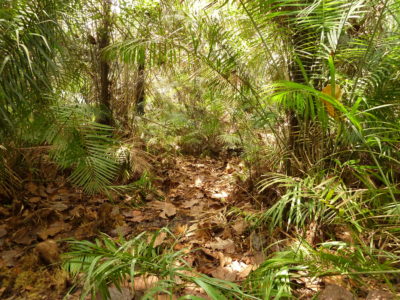From the Amazon to the jungles of central Africa and Southeast Asia, previously unknown peatlands are emerging as a new focus in the fight against climate change. Scientists have been telling us for some time that protecting the planet’s climate will require conserving tropical peatlands as well as rainforests. But the true extent of these giant stores of underground carbon is only now beginning to emerge.
They keep turning up, each one seemingly bigger than the last. Each holds many times more carbon than the visible trees above ground. And as the frontiers of cultivation extend into ever more remote regions, their vulnerability to both fires and draining for agriculture – oil palm plantations in particular — is growing fast.
The Pastaza-Marañón swamp, which surrounds the Marañón River in northeastern Peru, is one of the world's largest peatlands, covering 35,000 square kilometers. Courtesy of Oscar Jarama/IIAP
The latest, and biggest, discovery came in February, when Simon Lewis and colleagues from Leeds University in the UK revealed the results of an expedition to a remote part of the Republic of the Congo (formerly Congo Brazzaville). The Cuvette Centrale region, once a giant lake and now home to lowland gorillas and forest elephants, turns out to contain the world’s largest tropical peat swamp.
The peat — the accumulation of dead timber has fallen into stagnant water over the past 10,000 years — is several meters thick and covers 150,000 square kilometers, an area larger than England. It harbors an estimated 30 billion tons of carbon. That is as much as is stored in all the trees in the rainforests of the Congo basin, and equivalent to 20 years of carbon dioxide emissions from the U.S.
This startling finding came just two years after another team of British geographers emerged from the jungles of Peru to report a large and previously unmapped peatland covering 35,000 square kilometers of the upper Amazon basin in northeastern Peru. The Pastaza-Marañón swamp is, according to co-author Katy Roucoux of the University of St Andrews in Scotland, “the most carbon-dense landscape in Amazonia.” It covers just 3 percent of forested Peru, but contains 3 billion tons of carbon — almost half as much carbon as in all the country’s above-ground forests.
Researchers have only scratched the surface of underground peat reserves and the enormous carbon storehouse they represent.
Peatlands comprise soils that are made up largely of organic matter that has not decomposed because the swamps contain no oxygen. They are thus very carbon-rich. They cover less than 5 percent of the earth’s surface, but store more than twice as much carbon as all the world’s forests.
With the new discoveries, the race is on to find more hidden tropical peatlands and protect them before they are lost to the spread of oil palm. There could be a lot left to find. Last month, a new modeling assessment of places likely to have the conditions for peat swamps concluded that field researchers have so far only scratched the surface of the underground peat reserves and the enormous carbon storehouse they represent.
In an article in the journal Global Change Biology, Thomas Gumbricht, a scientific consultant at the Center for International Forestry Research (CIFOR) in Bogor, Indonesia, reported last month that tropical peatlands are likely to cover an area more than three times greater than currently calculated, 1.7 million square kilometers rather than 440,000 square kilometers. And their volume could be almost four times greater, at some 7,000 cubic kilometers, which would suggest that the world’s tropical peatlands may contain not 88 billion tons of carbon, but 350 billion tons, or more than 200 years of U.S. greenhouse gas emissions.
Gumbricht’s study was no back-of-an-envelope calculation. “It took me five years, including developing new methods of hydrological modelling, landform assessment, and new algorithms for retrieving soil moisture from optical satellite data,” he told Yale Environment 360. His findings show how haphazard field exploration for peat has been, he said. “Peatlands have been seen as wastelands… there are almost no records on their extent. Even scientists tend to regurgitate old maps [that] omit pristine wetlands.”
Field researchers involved in the new finds agree. Lewis said that the giant peat swamp he uncovered in the Congo had “been wrongly classified in all previous maps.” Ian Lawson, a member of the St Andrews team working in Peru, said: “It’s certain we don’t know the full extent of tropical peatlands. There are lots of floodplains in Amazonia and in other parts of the tropics that are yet to be looked at for peat.”
Susan Page of Leicester University in England, the author of the old estimate of the extent of tropical peatlands, is skeptical of Gumbricht’s findings, however. “I do not trust his peat methodology at all,” she said. “He greatly overestimates the depth of the [newly discovered] Congo peatland. I would expect a similar, and perhaps more dramatic, overestimation in South America.” Many seasonal wetlands there “are not peat-accumulating,” she said.
Alexandra Barthelmes, a landscape ecologist at Greifswald University in Germany, said Gumbricht’s study was “a valuable achievement,” but might have resulted in “a considerable overestimation.”
Gumbricht concedes that his startling new global estimate of peatlands could overestimate in some areas by not allowing for peat lost due to fires or river erosion. But it could underestimate elsewhere, omitting likely peat deposits in African wetlands such as the Okavango, Sudd, and Niger inland delta, he said. For sure, “far more peat exists in the tropics than previously estimated.” Once, it was thought that the planet’s peat was mostly beneath the tundras of Canada, Alaska, and Siberia, where low temperatures slow decomposition. During the 1990s, it became clear that waterlogged swamps on the Indonesian islands of Sumatra and Borneo contained rich deposits of peat up to 15 meters deep.
University of St Andrews ecologists collect peat samples from the Pastaza-Marañón swamp in the Peruvian Amazon. Courtesy of Katy Roucoux
For a long time, says Lawson, these Southeast Asian peatlands appeared to be an anomaly. “It seemed counterintuitive that peat could accumulate in hot tropical environments where plant litter decomposes very fast. But now we realize that waterlogging is more effective than had been assumed in slowing the rate of decomposition, regardless of temperature.” If Gumbricht is proved right, it will mean that almost half the peatland carbon is in the tropics.
Scientists have long known about the existence of tropical swamps, of course. Explorers have been wading through them since the Victorian heyday of David Livingstone and Henry Stanley in Africa. But their peat content has gone largely unnoticed. Not all swamps contain peat and “it is very difficult reliably to detect peat remotely,” says Lawson. “There is still no substitute for going out there with a peat auger” to bore into the swamp.
In search of peat in the swamps of the Congo, Lewis and his fellow 21st century British researchers took an almost identical waterlogged journey to the one described by travel writer Redmond O’Hanlon in his 1996 book, Congo Journey. But, unlike their predecessor, they took a peat auger with them to drill into the swamp and discover the content of its soggy soils.
Peat swamps, and the buried carbon they contain, are extremely vulnerable to cultivators, who drain them before planting their crops. As the swamps dry out, the peat oxidizes. The carbon turns to carbon dioxide and escapes into the atmosphere.
In Southeast Asia, peat swamps have been drained to plant oil palm and tree monocultures for pulp and paper.
This has happened already on a huge scale across Southeast Asia, where peat swamps have been drained to plant oil palm — one of the world’s most profitable and fastest expanding crops, used in a huge variety of consumer products from food to cosmetics — and tree monocultures for pulp and paper.
In Indonesia, a 25-year rotation of oil palm typically causes the oxidation of more than 400 tons of carbon per hectare, according to Kristell Hergoualc’h of CIFOR. Indonesian emissions from peat oxidation currently total around 150 million tons of carbon a year, according to Marcel Silvius of Wetlands International, a Netherlands-based NGO campaigning to protect the peatlands. That total roughly equals the annual emissions from fossil fuel burning in Canada.
Drying peat also becomes vulnerable to fires, often set by farmers clearing forests for oil palm. The fires release the carbon even more rapidly. Most of the smoke and carbon emissions during the fires that regularly produce spectacular hazes across Southeast Asia come not from burning trees but from smoldering underground peat. During September and October 2015, emissions from the forests and swamps of Indonesia were higher than those from the entire economy of the U.S. Through a mixture of oxidation and burning, roughly 60 percent of Indonesia’s known peatlands have been lost in recent decades, according to Silvius.
Until recently, 90 percent of the world’s oil palm was grown in Indonesia and Malaysia, with one-fifth of that cultivation on peatlands. But Indonesia’s president Joko Widodo has promised to protect what is left of his country’s peatlands. In response, plantation companies are seeking lands elsewhere. Silvius warns that that increasingly means the swamps of central Africa and South America where the enormous previously undiscovered peatlands were recently found.
Both of the two large peatlands discovered in the past three years are at risk. Lawson says the Peruvian peatland of Pastaza-Marañón is “threatened by the expansion of commercial agriculture linked to new transport infrastructure.” Cultivators have already moved into the neighboring region of Ucayali, where 22,000 acres of primary forest were recently cleared for an oil palm plantation. And the Peruvian government has plans for the first all-weather road into the peatland, linking it to the rest of Peru, as well as Brazil and Colombia.
Meanwhile in the Congo’s Cuvette Centrale, Lawson warns that “there are oil palm and timber concessions overlapping parts of our… peatland.” A Malaysian company, Atama Plantations, has a license to cultivate nearly 1.2 million acres, parts of which include the peatland.
Can the annexation be stopped? There are some hopeful signs. In Peru, Wetlands International is working with local partners to promote the sustainable cultivation of aguaje, a juice made from Mauritia flexuosa, the wild swamp palm. They see it as a way of harvesting the peatlands without destroying them. The Congolese government is considering expanding a community reserve around Lac Tele in the heart of the Cuvette swamp, according to the Wildlife Conservation Society, which manages the reserve.
Climate change funds may be available through REDD (Reducing Emissions from Deforestation and Forest Degradation), an initiative of the Paris climate agreement. REDD should pay to protect carbon-rich peat swamps as well as forests, says Lawson. Funding such schemes may prove harder now the U.S. administration has set its face against paying for climate-related aid projects. But one project is already underway in Peru in a small part of the Pastaza-Marañón swamp.
What is clear is that the discovery of these giant reserves of buried carbon in parts of the tropics threatened by agricultural development dramatically raises the stakes for conservation as a tool of climate protection. The implications of the findings, says Gumbricht, “are both good and bad.” On the bad side, there is a lot more carbon available for release into the atmosphere if things go wrong. But on the good side, “the potential for storing carbon in peatlands is also larger than previously thought.”
But how much good and how much bad? To answer such questions the world first needs to find out where the tropical peatlands are and how much carbon they contain. This will be “an enormous challenge,” says Hans Joosten, Barthelmes’ colleague at Greifswald University. But a good starting point would be to tap existing knowledge that Joosten and Barthelmes believe may be scattered in obscure archives and “largely unknown to modern researchers.” The pair have launched a Global Peatland Database to uncover such sources before it is too late.
Homepage photo credit: Kemal Jufri/Greenpeace



